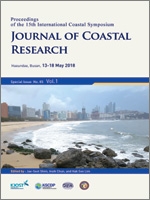Albuquerque, M.; Alves, D.C.L.; Espinoza, J.M.A.; Oliveira U. R., and Simões R. S., 2018. Determaning shoreline response to meteo-oceanographic events using remote sensing and unmanned aerial vehicle (UAV): case study in southern Brazil. In: Shim, J.-S.; Chun, I., and Lim, H.S. (eds.), Proceedings from the International Coastal Symposium (ICS) 2018 (Busan, Republic of Korea). Journal of Coastal Research, Special Issue No. 85, pp. 766–770. Coconut Creek (Florida), ISSN 0749-0208.
Meteo-oceanographic events are characterized by low pressure centers and intense winds. These systems are responsible for transferring a huge amount of energy from the atmosphere to the ocean that could cause serious socioeconomics damages to the coastal zones. Some of the consequences of these events propagation are an occurrence of large amplitude waves and an increase in the coastal water level. This study aims to characterize the effects of the extratropical cyclone in the southern Brazil occurred in October 2016, seeking a relationship between this event and the recent erosive episodes. Using satellite images and data obtained by unmanned aerial vehicle (UAV), it was possible to trace the shoreline behavior at time intervals, where occurred actions of extratropical cyclones during the year of 2016. The comparison of the shoreline position data, obtained by the image of July 2016, and the UAV (obtained in September and November 2016) presented an approximated shoreline retraction balance of 5.91 m associated for the cyclone that occurred between October 26th and 27th, 2016. This event was associated with synoptic pattern, which have feature cyclogenesis in the Southern Uruguayan coast with a displacement to the east and trajectory between 28° and 43°S, with winds of 17.9 m s−1 and SW direction. Associated with the meteorological aspects, erosive process is frequently accelerated or augmented by anthropogenic action, which is mainly related to building constructions activities and sometimes contributes to the destruction of dunes. After the passage of cyclone there was a partial or total destruction of 40% of beachfront houses and 65% of coastal protection structures. Therefore, this type of study constitutes a basic tool of general interest in the coastal management, contributing to understanding of the impacts and risks associated with the coastal dynamics and effects of the meteo-oceanographic events, along the Soutrhern Brazil.





